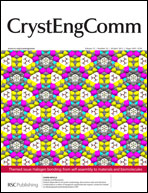The reaction of uranyl nitrate hexahydrate with 4-halopyridinium ions (X = Cl, Br, I) in high chloride media has resulted in three novel compounds, each of which is based around the [UO2Cl3(NO3)]2− tecton; (C5H5NCl)2[UO2Cl3(NO3)], (C5H5NBr)2[UO2Cl3(NO3)] and (C5H5NI)3[UO2Cl3(NO3)](NO3). In each material the halogen is involved in various forms of intermolecular interaction, including hydrogen bonding, halogen–halogen interactions and halogen–nitrate interactions. Presented is a discussion of the role of the halogen, in terms of Lewis acidity, in directing the overall structure.
You have access to this article
 Please wait while we load your content...
Something went wrong. Try again?
Please wait while we load your content...
Something went wrong. Try again?
![Graphical abstract: Metal–organic hybrids involving the [UO2Cl3(NO3)]2− tecton and the role of halogen polarizability](/en/Image/Get?imageInfo.ImageType=GA&imageInfo.ImageIdentifier.ManuscriptID=C2CE26561C&imageInfo.ImageIdentifier.Year=2013)

 Please wait while we load your content...
Please wait while we load your content...